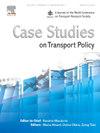Can AI-powered traffic enforcement system augment road safety by influencing driver behavior and perception?
IF 3.3
Q3 TRANSPORTATION
引用次数: 0
Abstract
Artificial Intelligence powered Enforcement Systems (AIES) are deployed across 675 locations in the state of Kerala, India to mitigate traffic violations and accidents. This fully automated enforcement system utilizes cameras powered by solar energy and 4G LTE (Long-Term Evolution) technology detect violations in real time and inform the drivers through different media. A comprehensive three-stage investigation is carried out in the present work to assess the effectiveness of AIES, which includes a machine learning-driven investigation of driver perception and behavior, crash data analysis, and spatial and temporal analysis of violation behavior. Artificial Neural Network model was instrumental in revealing the role of perception and experience towards change in driving behavior. DBSCAN (Density-Based Spatial Clustering of Applications with Noise) was used to categorize drivers into two segments based on their perception and behavior. Segment 1 showed reserved perception of AIES, with limited behavioral changes while segment 2 demonstrated a favorable perception and significant positive behavioral changes. The findings revealed a significant reduction in fatal accidents demonstrating the effectiveness of the system in enhancing road safety. Spatial analysis indicated a reduction in violations, particularly in areas where AI cameras were prominently placed. Temporal analysis showed marked improvements in helmet usage for both riders and pillion riders, highlighting the role of AIES in raising awareness and compliance. The study established the need for rotating the camera locations as the deterrent effect on violations is found diminishing with distance from the AIES units. The findings suggest that improving the communication and transparency of the system, while carefully considering the level of information revealed, could further reduce violations.
人工智能驱动的交通执法系统能否通过影响驾驶员的行为和感知来增强道路安全?
人工智能执法系统(AIES)部署在印度喀拉拉邦的675个地点,以减少交通违规和事故。这种全自动执法系统利用太阳能和4G LTE(长期演进)技术驱动的摄像头,实时检测违规行为,并通过不同的媒体通知司机。在目前的工作中,进行了一项全面的三阶段调查,以评估AIES的有效性,其中包括机器学习驱动的驾驶员感知和行为调查,碰撞数据分析以及违规行为的时空分析。人工神经网络模型有助于揭示感知和经验对驾驶行为变化的作用。采用DBSCAN(基于密度的噪声应用空间聚类)方法,根据驾驶员的感知和行为将驾驶员分为两类。第1段表现为对AIES的保留认知,行为改变有限;第2段表现为良好认知,行为改变显著。调查结果显示,致命事故大幅减少,显示该系统在加强道路安全方面的有效性。空间分析表明,违规行为有所减少,特别是在人工智能摄像头放置在显眼位置的地区。时间分析显示,骑手和骑枕骑手的头盔使用情况都有显著改善,突出了AIES在提高认识和遵守方面的作用。这项研究确定有必要旋转摄影机的位置,因为发现对违犯行为的威慑作用随着与AIES单位的距离而减弱。调查结果表明,在仔细考虑披露的信息水平的同时,改善该系统的沟通和透明度可以进一步减少违规行为。
本文章由计算机程序翻译,如有差异,请以英文原文为准。
求助全文
约1分钟内获得全文
求助全文

 求助内容:
求助内容: 应助结果提醒方式:
应助结果提醒方式:


